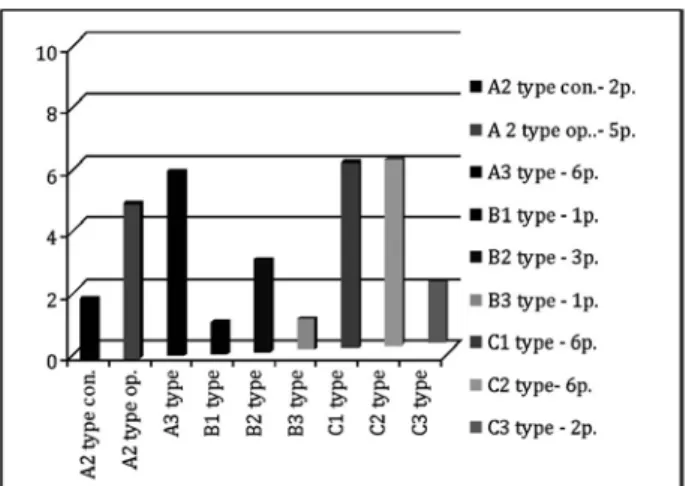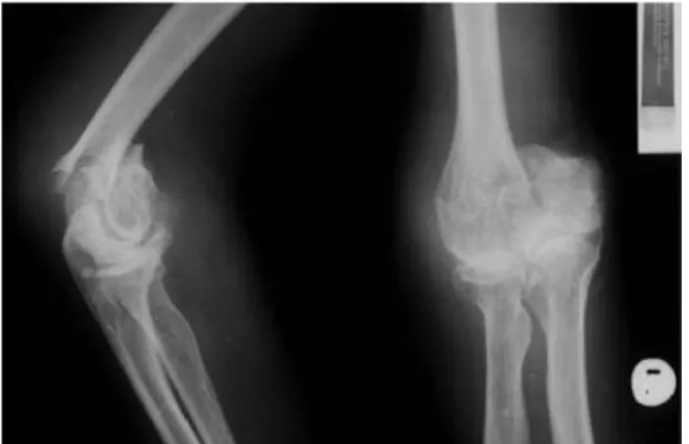ElEmEnts for suCCEssful funCtionAl rEsult
AftEr surgiCAl trEAtmEnt of intrA-ArtiCulAr
distAl humErAl frACturEs
nikica daraboš1, ivana dovžak Bajs1, srećko sabalić1, roman Pavić1, Anela daraboš2 and tomislav Čengić1
1university hospital for traumatology, sestre milosrdnice university hospital Center, Zagreb; 2scientific unit,
Varaždin general hospital, Varaždin, Croatia
summArY – intra-articular distal humeral fractures (dhf) present great challenge to an or-thopedic-trauma surgeon. We analyzed the relationship between functional results of dhf surgical treatment and elements that can affect patient recovery. during the 5-year follow-up study, 32 pati-ents were treated for dhf at our trauma department, 30 of them by surgical procedure. functional results of surgical treatment were scored according to the Jupiter criteria. According to the A-o classification of dhf, there were 11 type A fractures, 5 type B fractures and 14 type C fractures. Postoperative complications were infections, neural lesions, inadequate healing, and instability of osteosynthesis. Analysis of functional results in patients with operated C type fractures according to different elements influencing postoperative result revealed correct healing in 74% of patients, which was statistically significantly higher than the percentage of unsatisfactory results (p<0.05). study results provided evidence for patient age, sex, infection, neural function preservation, succe-ssful and rigid fixation, anatomical reconstruction of articular surface, and early rehabilitation to be significant elements for successful functional recovery.
Key words: Distal humeral fractures; Surgical treatment; Osteosynthesis; Patient recovery
Correspondence to: Nikica Daraboš, MD, PhD, university hos-pital for traumatology, sestre milosrdnice university hoshos-pital Center, draškovićeva 19, hr-10000 Zagreb, Croatia
E-mail: [email protected]
received march 5, 2012, accepted may 5, 2012 Introduction
intra-articular distal humeral fractures (dhf) present great challenge to an orthopedic-trauma sur-geon. Considering the biomechanics, this anatomical region can be expanded to the elbow joint and to the proximal part of the forearm.Except for changes in the articular surface, fracture can cause damage to soft tissues such as muscles, vascular and neural structures, tendons and ligaments, and joint capsule1.Therefore,
clinical examination (neurologic status, vascular sta-tus, radiologic examination) is of great importance in preoperative treatment of the patient2.
depending on the type of fracture and possible complications, dhf can be treated conservatively or operatively3,4.major neurovascular lesions (nerve
paralysis, brachial artery injury with compartment syndrome) are indications for urgent operative treat-ment5.
Postoperative complications can include skin ne-crosis, dehiscence or infection; neural lesions, such as transient neurapraxia, paresis or paralysis of radial, median or ulnar nerve; vascular lesions, e.g., brachial artery with compartment syndrome development; bone lesions, e.g., instability of osteosynthesis, malpo-sition of fragments, dislocations, ectopic ossifications, non-healing of fragments, osteomyelitis, or arthritis5.
in this study, we analyzed the relationship between the results of surgical treatment of dhf and different elements influencing patient recovery.
Patients and Methods
during this 5-year follow-up study, 32 patients were treated for dhf at our trauma department. functional result of surgical treatment was scored ac-cording to the Jupiter criteria.
in the group of 30 operatively treated patients, there were 20 female (average age 47 years) and 10 male patients (average age 51 years). The following medical data were analyzed: general data, history, clinical examination, description of the operating pro-cedure, x-ray images before and after the propro-cedure, clinical tests and x-ray images obtained on follow-up on visits until the end of treatment.
According to the A-o classification of dhf, there were 11 type A fractures (A2, 5 patients; and A3, 6 patients), 5 type B fractures (B1, 1 patient; B2, 3 pa-tients; and B3, 1 patient) and 14 type C fractures (C1, 6 patients; C2, 6 patients; and C3, 2 patients). The results are shown in figure 1.
All patients were examined upon admission to Emergency room. local status was very similar in all patients and included swelling, hematoma, deformity, and pain in distal upper arm. radiologic examination (x-rays: AP, ll) confirmed the diagnosis of dhf. neurovascular tests were performed and paresthesia was found in 2 patients (1 in the region of radial nerve and ulnar nerve each). All patients were treated with immobilization procedure, anticoagulant and anal-gesic therapy. Preoperative anesthesiology examina-tion was followed by operative procedure within 4-72 hours (median, 20 hours).
operative treatment of dhf implied posterior ex-posure (lateral or medial in alternative), angular inci-sion of the skin and osteotomy of the olecranon, iden-tification and preparation of anatomical structures, isolation of ulnar nerve and in alternative radial nerve. After flexion in elbow joint of 140°, inspection of frac-ture fragments was performed, followed by anatomical reposition: first at the trochlear segment and then at the metaphysis of distal humerus. K wires were used for temporary fixation. osteosynthesis was done with the use of screws and reconstruction plates or Y plate. final part of the procedure was osteosynthesis of the olecranon and sutures of each layer.
The operative treatment was followed by stationary rehabilitation at the trauma department and ambula-tory at the department of Physical medicine and
re-habilitation. Postoperative treatment was started with splint immobilization for 7 days. After 4 postopera-tive days, the patient was allowed to do acpostopera-tive elbow movements, and after 6 weeks passive movements and stretching of the elbow joint were allowed.
statistical significance of the relationship between the percentage of satisfactory and unsatisfactory treat-ments according to different eletreat-ments influencing postoperative result in the group of patients operated on for dhf was calculated using χ2-test.
Results
during the 5-year follow-up, 32 patients were treated for dhf at our trauma department, 30 of them with surgical procedure, while 2 patients under-went conservative treatment.
The following postoperative complications were re-corded: non-healing fracture in 1 patient; infection in 1 patient with type C2 fracture; transient neurapraxia in 2 patients (ulnar nerve in 1 patient with type B1 fracture and radial nerve in 1 patient with type C2 fracture); and instability of osteosynthesis in 2 pa-tients with type C2 and C3 fracture.
functional results of surgical treatment were scored according to the Jupiter criteria with a follow-up pe-riod of 0.5 to 5 years (median, 3 years). Jupiter criteria consist of a grading scale which represents function and movements of the elbow joint determined by clinical examination: 1) Elbow joint range of mo-tion: flexion, extension, pronation and supination; 2)
Fig. 1. Results according to the A-O classification of distal humerus fracture.
Amount of pain (subjective); 3) X-ray image – stage of arthrosis; and 4) Amount of disability (subjective). According to the Jupiter criteria, postoperative results were classified as satisfactory (excellent and good) and unsatisfactory (weak and poor). results were classi-fied according to the type of dhf treated: B1 type, 1 patient with excellent result (100% satisfactory); B2 type, 3 patients with excellent result (100%); B3 type, 1 patient with good result (100%); C1 type, 1 patient with excellent result, 4 patients with good result and 1 patient with weak result (83%); C2 type, 1 patient with excellent result, 2 patients with good result (figs.
Fig. 2-3. Preoperative x-ray of distal humerus fracture (AP and LL).
Fig. 4. Postoperative x-ray of surgically treated distal hu-merus fracture.
2-6) and 3 patients with weak result (50%); and C3 type, 1 patient with good result and 1 patient with poor result (50%) (fig. 7).
Accordingly, dhf treatment proved excellent in 26%, good in 48%, weak in 21% and poor in 5% of patients. in total, there were 74% of satisfactory re-sults and 26% of unsatisfactory rere-sults (fig. 8). The relationship between the percentage of satisfactory and unsatisfactory treatments according to different elements influencing the postoperative results in the group of dhf patients operated on was statistically significant (p<0.05).
Discussion
Years of experience in treating dhf have shown that prognosis for both operative and conservative treatment is poor6.intra-articular B and C types of
dhf along with dislocation of fragments followed by articular surface damage and associated complications are certain indication for operative treatment4.only
perfect intraoperative reposition of fragments with stable fixation of fracture with screws and reconstruc-tive or Y plates can ensure good healing and later sat-isfactory function of the elbow joint7-10.
There are a few elements that significantly affect the treatment and recovery of dhf. depending on the type of dhf, we can predict in advance what type of treatment will be required, what will be the rate of rehabilitation, and accordingly the treatment progno-sis. it is evident from our study through comparison of dhf fracture types and results that a more com-plicated type of fracture is associated with a lower rate of satisfactory results and viceversa.
it is certain that patients of older age and female patients with a higher incidence of osteoporosis have a predisposition for poor treatment results. We pre-sumed that it was the reason for weak and poor results in 2 patients (types C2 and C3) with postoperative complication of unstable osteosynthesis.
Pre- and postoperative infections can lead to poor treatment results as well, which was the reason in 1 patient (type C2). furthermore, preservation of nor-mal neural function is a prerequisite for successful and early physical therapy (2 study patients had transient neurapraxia). rehabilitation must be graded strictly individually; higher loads in the area of fracture have to be planned according to radiological follow-up im-ages and healing of bone defects.
Analysis of the results of treatment in patients with dhf (types B and C) according to different elements that influence the functional postoperative result by use of the Jupiter criteria showed satisfactory results in 74% of patients, yielding a significant difference com-pared to the rate of unsatisfactory results.
our study results provided evidence for patient age, sex, infection, neural function preservation, suc-cessful and rigid fixation, anatomical reconstruction of articular surface, and early rehabilitation to be sig-nificant elements for successful functional recovery after dhf.
Fig. 7. Quality of postoperative clinical status according to the AO classification.
Fig. 8. Quality of distal humeral fracture treatment according to clinical status.
Excellent Good Weak Poor
48%
26% 5%
References
1. hAnČEVić J, et al. lomovi i iščašenja. Jastrebarsko: nak-lada slap, 1998.
2. sChAtZKEr J, tilE m. The rationale of operative frac-ture care. Berlin-heidelberg-newYork: springer, 1987. 3. mullEr mE, nAtZAriAn s, KoCh P. Classification
Ao des fractures. Berlin-heidelberg-newYork: springer, 1987.
4. mullEr mE, AllgoWEr m, sChnEidEr r, Wil-lEnEggEr m. manual osteosynthese, 2nd edn.
Berlin-heidelberg-newYork: springer, 1977.
5. morrEY Bf. The elbow and its disorders. Philadelphia: WB sunders Co., 1985.
sažetak
ElEmEnti ZA usPJEšAn funKCionAlni rEZultAt nAKon KiruršKog liJEČEnJA intrAArtiKulArnih PriJElomA distAlnog humErusA
N. Daraboš, I. Dovžak Bajs, S. Sabalić, R. Pavić, A. Daraboš i T. Čengić
intraartikularni prijelomi distalnog humerusa predstavljaju velik izazov za svakog traumatologa-ortopeda. Analizirali smo povezanost funkcionalnih rezultata kirurškog liječenja intraartikularnih prijeloma distalnog humerusa te čimbenika koji bitno utječu na oporavak. u razdoblju od 5 godina na našem odjelu za traumatologiju obrađeno je 32 bolesnika s prijelomom distalnog humerusa, od kojih je njih 30 bilo operacijski liječeno. funkcionalni rezultat kirurškog liječenja ocje-njivao se prema kriteriju Jupiter. Prema A-o klasifikaciji prijeloma distalnog humerusa u operiranih bolesnika bilo je 11 prijeloma tipa A, 5 tipa B i 14 tipa C. Poslijeoperacijske komplikacije uključivale su infekcije, neuralne lezije, nesraštanja, te nestabilnost osteosinteze. Analizom funkcionalnog rezultata operiranih prijeloma tipa C s obzirom na elemente koji utječu na funkconalan poslijeoparacijski status na temelju kriterija Jupiter 74% bolesnika imalo je zadovoljavajuće rezultate, što je u usporedbi s postotkom nezadovoljavajućih rezultata bilo statistički značajno (p<0,05). rezultati pokazuju da su dob, spol, infekcija, očuvanje neuralne funkcije, uspješna rigidna fiksacija, anatomska rekonstrukcija zglobne površine i rana rehabilitacija značajni čimbenici za uspješan funkcionalni oporavak.
Ključne riječi: Prijelomi distalnog humerusa; Kirurško liječenje; Osteosinteza; Oporavak bolesnika
6. smilJAnić B. traumatologija. Zagreb: školska knjiga, 1994.
7. mAst J, JAKoB r, gAnZ r. Planning and reduction technique in fracture surgery. Berlin: springer, 1989. 8. BuhrEn V, trEntZ o, hEnnEBErgEr g.
Prin-zipen der reposition technik bei luxationen und frakturen. Chirurg 1990;61:743.
9. PrAsArn ml, Ahn J, PAul o, morris Em, KA-lAndiAK sP, hElfEt dl, loriCh dg. dual plating for fractures of the distal third of the humeral shaft. J orthop trauma 2011;25:57-63.
10. PoPoViC d, King gJ. fragility fractures of the distal hu-merus: what is the optimal treatment? J Bone Joint surg Br 2012;94:16-22.


